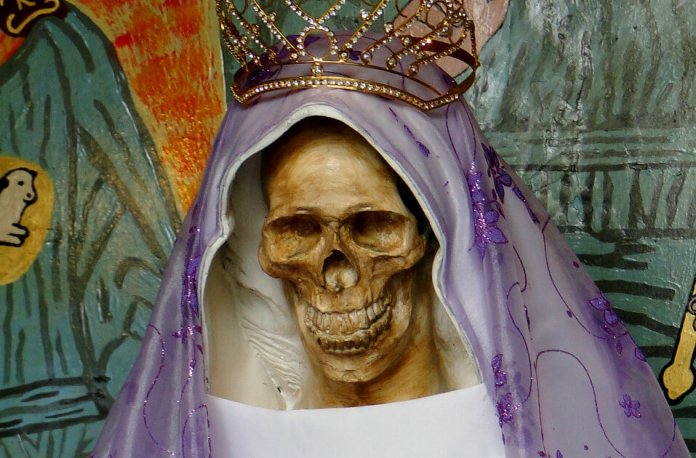The right to rank people as saints is “reserved” for the Church. But there are people (including characters in legends) and even animals who are considered saints without the permission of religious leaders. These saints are often credited with rather original abilities or deeds that they performed during life or after death.
Here are the top 10 saints who have not been recognized by any religion in the world, and most likely never will.
10. Jesus Malverde, patron saint of drug dealers
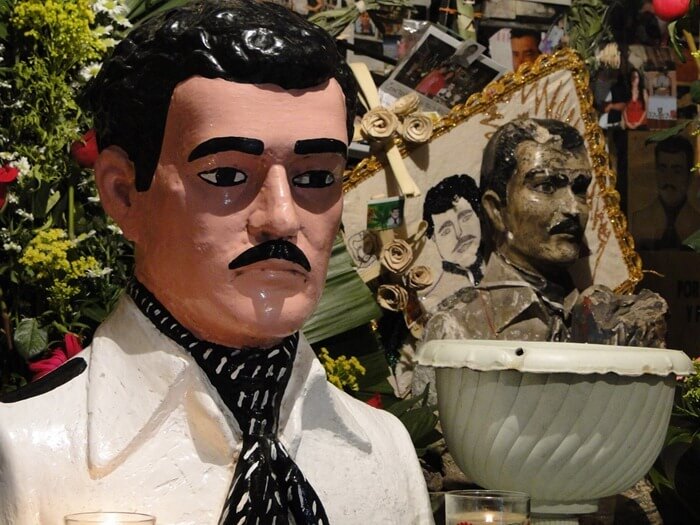 Jesus was born in 1870 near the city of Culiacan in the state of Sinaloa and lived a quiet life until his parents died. Then everything changed. Malverde became an extra-class thief, a kind of Mexican Robin Hood. He stole from the rich and gave generous gifts to his poor fellow citizens. For such "feats" the authorities seized Jesus and executed on May 3, 1909.
Jesus was born in 1870 near the city of Culiacan in the state of Sinaloa and lived a quiet life until his parents died. Then everything changed. Malverde became an extra-class thief, a kind of Mexican Robin Hood. He stole from the rich and gave generous gifts to his poor fellow citizens. For such "feats" the authorities seized Jesus and executed on May 3, 1909.
While there is no evidence that Jesus was involved in the drug trade, he has a large following among Mexican drug dealers.
During the rise of Mexican drug cartels in the 1980s and 90s, the popularity of the Malverde cult skyrocketed. Association with the "angel of the poor" has allowed some drug cartels to create a heroic areola around their criminal business.
To this day, many Mexican drug dealers pray to Malverde, hoping that he will save them from the police. They often visit his chapel, which is located in the center of Culiacan.
9. Juan Soldado, patron saint of migrants
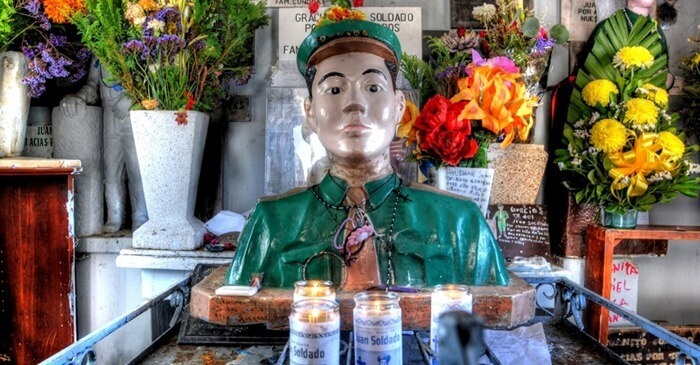 Another unrecognized Mexican saint. It is considered the patron saint of people who illegally cross the border between the United States and Mexico.
Another unrecognized Mexican saint. It is considered the patron saint of people who illegally cross the border between the United States and Mexico.
In 1938, a terrible crime took place in the city of Tijuana. An 8-year-old girl was raped and killed. The townspeople were furious. The suspect - or the scapegoat - was quickly found, the soldier Juan Castillo Morales.
The crowd threatened to lynch him, and a hastily assembled military tribunal passed the verdict in just one night, without even checking for Juan's fingerprints on the evidence. He was sentenced to death by extrajudicial execution ley de fugas - "mock escape." This is a brutal ritual during which a person had to run to the border, hoping to avoid a bullet in the back. Before Juan could reach American soil, he was mortally wounded.
When the townspeople tried to wash Morales' blood off the ground, they were unable to do so. Declaring it a miracle, they built a chapel on the soldier's grave. Now illegal migrants who are going to get from Mexico to the United States pray to Juan Soldado for a successful trip.
8. Saint Ginfort, patron saint of children
 This story about the only animal on the list of unrecognized saints - a Greyhound named Ginfort - dates back to the thirteenth century. It says that a knight who lived near Lyon went hunting and left Ginforth to guard his young son. While the owner was absent, a snake crept into the room with the child.However, Ginfort attacked the reptile and tore it to pieces, although he himself was bitten many times. While the dog and the snake fought, they turned the cradle over and left blood stains on the floor.
This story about the only animal on the list of unrecognized saints - a Greyhound named Ginfort - dates back to the thirteenth century. It says that a knight who lived near Lyon went hunting and left Ginforth to guard his young son. While the owner was absent, a snake crept into the room with the child.However, Ginfort attacked the reptile and tore it to pieces, although he himself was bitten many times. While the dog and the snake fought, they turned the cradle over and left blood stains on the floor.
Returning and seeing a greyhound with a bloody mouth, the lord fell into a rage, deciding that his faithful dog tore the child to pieces. He drew his sword and killed Ginforth. Only then did the family see the baby sleeping peacefully under the inverted cradle.
Realizing that he had unjustly accused and killed Ginfort, the owner took the dog's body and put it in a well, filling it with stones on top. He also planted trees next to the makeshift grave to commemorate the brave dog.
And local peasants, having learned that Ginfort had saved the baby, began to visit his grave and pray for the health and well-being of their children. Despite the fact that the Catholic Church not only discouraged, but also outright forbade the worship of animals, the veneration of Ginforth persisted until 1930.
7. Miguel Angel Gaitan, wonder child
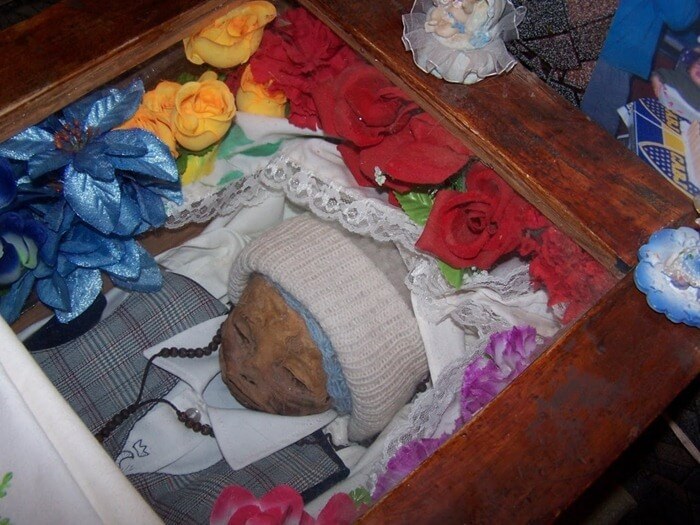
Little Argentinian Miguel died of meningitis in 1966, before his first birthday. However, miracles with his participation began in 1973. A violent storm destroyed the tomb of brick and cement, under which the child's coffin rested. At the same time, the remains of Miguel were practically intact.
After several attempts to build the tomb, which collapsed the next day, the locals decided to leave the coffin in the open air. And then the lid began to disappear from the coffin.
“We put stones and heavy objects on the lid, but every morning we discovered that they were missing,” said Miguel's mother. “Finally we decided that Miguel didn’t want to be locked up, he wanted to be seen.”
The boy is now in a small blue wooden coffin with a glass lid. Through it, you can see Miguel's dry and brown face, and his mother regularly changes her son's clothes. Believers from all over the world come to look at the miracle child, ask for blessings and success in business, and leave him toys, models of cars and bicycles, teddy bears, and souvenirs in the shape of a heart or with drawings of little angels.
6. Evgeny Rodionov, warrior-great martyr
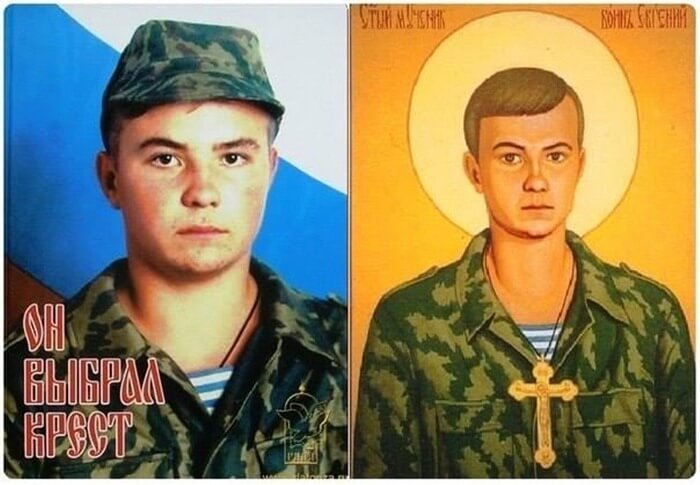 The Russian saint, not yet recognized by the Orthodox Church, serves as an example of courage and honor for many. During the first Chechen campaign, he, along with several colleagues, spent a long time in captivity and experienced severe torture.
The Russian saint, not yet recognized by the Orthodox Church, serves as an example of courage and honor for many. During the first Chechen campaign, he, along with several colleagues, spent a long time in captivity and experienced severe torture.
Before executing the soldiers, the militants suggested that Rodionov remove his pectoral cross, renounce Christianity and convert to Islam. In return, they promised to keep the young man alive. But Eugene refused. He became a popular hero, a martyr for the faith, and an unofficial saint.
In Russia, over 160 icons of Eugene were written, and in honor of his feat a book for children entitled "The Lay of the Soldier" was published.
5. Jose Tomás de Sousa Martins, patron saint of the seriously ill
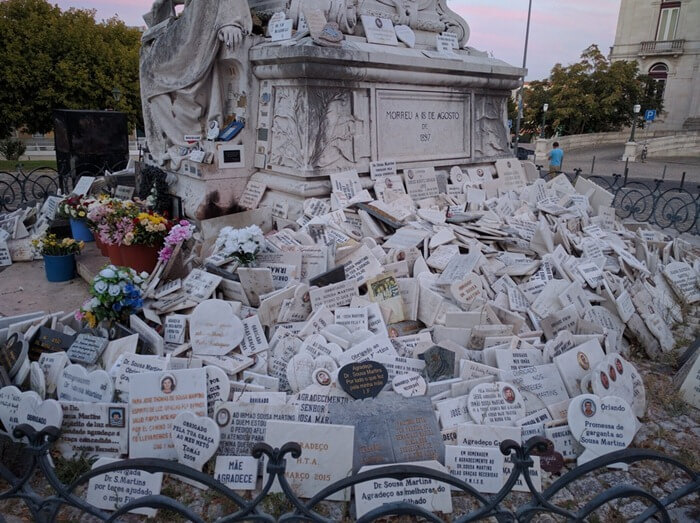 In Lisbon, next to the building of the Faculty of Medicine, there is a monument to a doctor who specialized in the treatment of tuberculosis. Poor townspeople were his patients. Dr. Jose's kind and caring attitude towards low-income patients was an example of medical ethics for his colleagues.
In Lisbon, next to the building of the Faculty of Medicine, there is a monument to a doctor who specialized in the treatment of tuberculosis. Poor townspeople were his patients. Dr. Jose's kind and caring attitude towards low-income patients was an example of medical ethics for his colleagues.
However, the one who fought with a terrible disease himself became its victim. Martins died in 1897. However, the respect and love for the "doctor for the poor" among the people were so great that he was credited with healing abilities even after death. Near the Martins monument, there are a lot of marble tablets with gratitude for the cure of serious ailments.
4. Teresa Urrea, healer
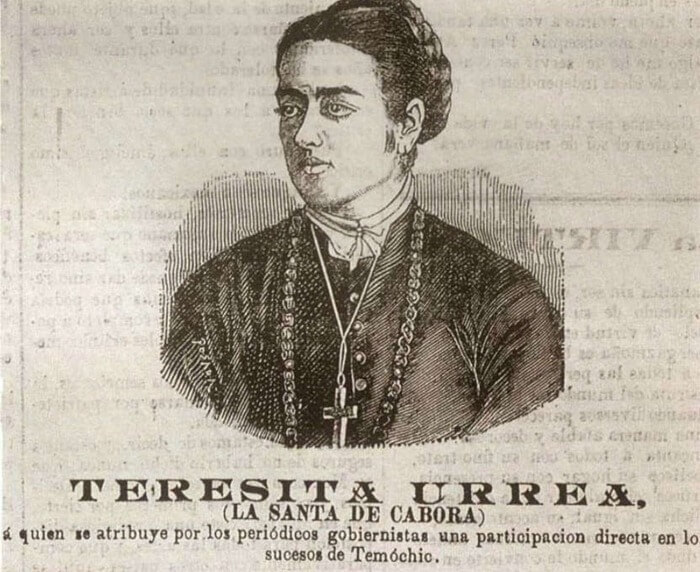 This woman, also known as Teresita and "Little Saint Kabora", was able to heal people with cancer, blindness, stroke and paralysis. Luis Urrea, novelist and great-nephew of Teresa, described how she rescued a young cowboy who was kicked by a mule. Teresa picked up a handful of earth and spat into it, then rubbed the "medicine" into the man's wound, which led to instant healing.
This woman, also known as Teresita and "Little Saint Kabora", was able to heal people with cancer, blindness, stroke and paralysis. Luis Urrea, novelist and great-nephew of Teresa, described how she rescued a young cowboy who was kicked by a mule. Teresa picked up a handful of earth and spat into it, then rubbed the "medicine" into the man's wound, which led to instant healing.
After rumors of Teresa's incredible abilities spread throughout Mexico, thousands of sick people began to flock to the ranch where she lived.
Teresa preached justice for all people, and the cry "Viva la Santa de Cabora" became a battle cry for several Indian tribes who rebelled against the agrarian policies of the dictator Porfirio Diaz.
In 1910, Diaz expelled Teresa from the country, calling her "the most dangerous girl in Mexico."
She ended up in the United States, where she continued to treat people and remained a politically active person. The healer called for the abolition of all laws or social practices that lead to inequality "based on gender, race, nationality or class." Teresita died in 1906 of tuberculosis, at the age of 33.
3. Antonio "Gauchito" Gil, people's saint
 Another "Robin Hood" in the ranking of the most revered unofficial saints. Legend has it that Gauchito (translated as "Cowboy") was an Argentine farmer who went to war with Paraguay. Then he returned home, but the civil war broke out and Antonio was again forcibly sent into the army. Not wanting to fight, he deserted and began "robbing the rich and gifting the poor."
Another "Robin Hood" in the ranking of the most revered unofficial saints. Legend has it that Gauchito (translated as "Cowboy") was an Argentine farmer who went to war with Paraguay. Then he returned home, but the civil war broke out and Antonio was again forcibly sent into the army. Not wanting to fight, he deserted and began "robbing the rich and gifting the poor."
Of course, the government did not like Hill's activities. He was hunted down and eventually captured. Before his death, Antonio told one of his executioners that if the execution took place, his son would get sick. Returning home, the police officer discovered that his child was indeed ill. Only a prayer addressed to Gauchito was able to heal the boy.
This is how the legend of Saint Gauchito Gil was born. Until now, in Argentina, many people ask him for protection and help.
2. Saint Sarah, patroness of Roman Catholics
 The first historical mention of Sarah is contained in the text "The Legend of St. Mary", written in 1521 by Vincent Philippon. In this version of the legend, Sarah lived and traveled through the French Camargue, providing for the needs of a small Christian community. It seems that Sarah's begging practice gave the early writers a good reason to make her a gypsy. However, its exact origin is unknown.
The first historical mention of Sarah is contained in the text "The Legend of St. Mary", written in 1521 by Vincent Philippon. In this version of the legend, Sarah lived and traveled through the French Camargue, providing for the needs of a small Christian community. It seems that Sarah's begging practice gave the early writers a good reason to make her a gypsy. However, its exact origin is unknown.
According to another legend, Sarah was the servant of Maria Salome and Maria Ostensibly. One day, three women were traveling by sea and were caught in a violent storm. Then Sarah directed the ship on the right course to the shore, guided by the stars.
Finally, the third legend says that Sarah was the head of a gypsy tribe that lived on the banks of the Rhone. The woman had visions of helping the saints who were present at the time of Jesus' death. Sarah saw that their boat could not land as the sea was too rough. Then Sarah threw her dress onto the waves and, using it as a raft, sailed to the saints. She helped them get to land and became the first Christian among the gypsies.
1. Santa Muerte, Holy Death
 This deity, personifying death, is unlikely to be recognized by any religion. However, Santa Muerte has around 12 million fans in Mexico and the United States. Basically, criminals, single mothers and street children, drug addicts and the unemployed pray to Holy Death.
This deity, personifying death, is unlikely to be recognized by any religion. However, Santa Muerte has around 12 million fans in Mexico and the United States. Basically, criminals, single mothers and street children, drug addicts and the unemployed pray to Holy Death.
Followers of Santa Muerte say that the advantages of this deity lie in its unbiased attitude (everyone is equal before Death), and also in the supposed ability to provide what you want in exchange for unpretentious offerings - cigarettes and flowers.

